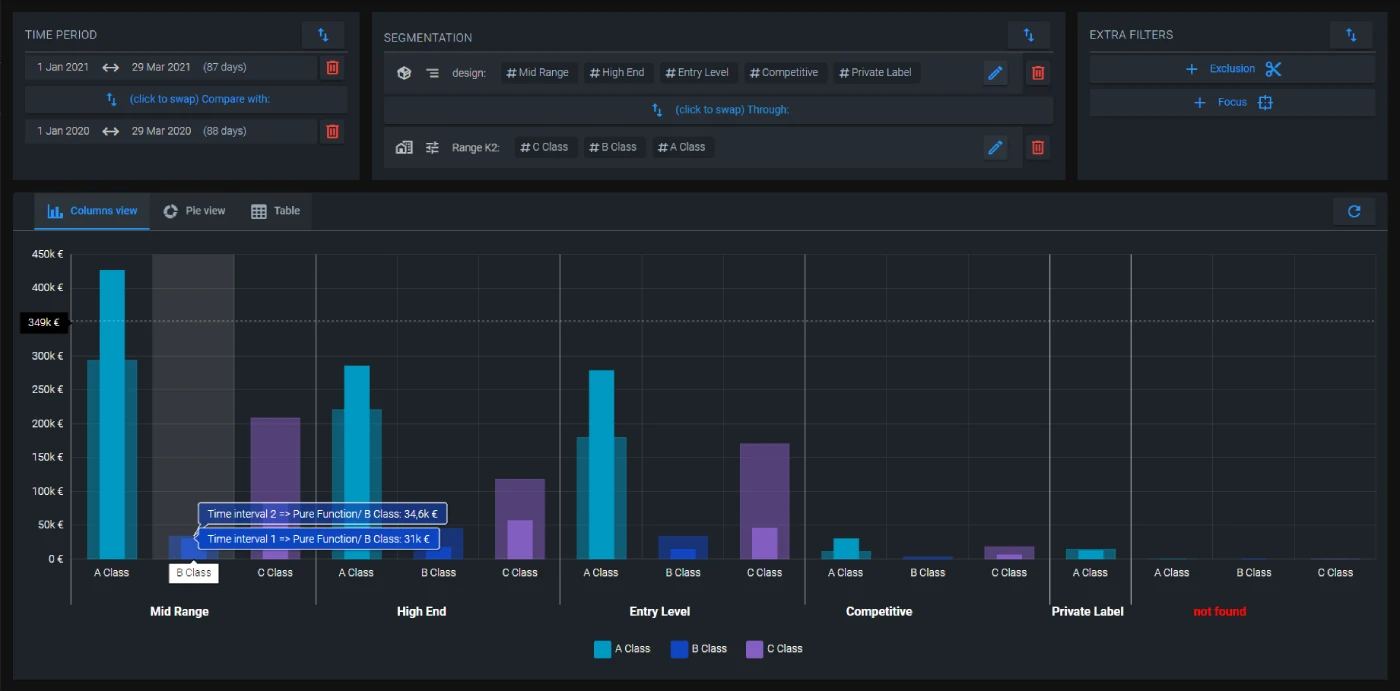Multi-level Segmentation
What it Means
The concept of segmentation is well-known, but multi-level segmentation is a more advanced method of dividing data. This approach starts from broad categories and moves into specific details. A commonly understood example is the categorization and subcategorization of products. Another example is geographic segmentation: regions -> subregions -> countries -> states -> counties. This method allows for a granular analysis tailored to the needs of each market segment.
Where it’s Applied
This method is used by companies that have a large number of products and/or clients, typically in the thousands or tens of thousands, and that operate using a B2B model.
Criteria for Customer Segmentation
- Importance: This segmentation, also known as ABC segmentation, is based on revenue. The Pareto Principle (80-20%) is extended by adding an additional category. If the number of customers is large, additional levels can be added, typically named A1, A2, A3, B1, B2, etc. This segmentation is used to define “go-to-market” strategies by adjusting costs and prices.
- Industry Verticals: Segmentation by industry verticals allows the offer to be adapted to the specific needs of each sector, thus optimizing the sales strategy.
- Geographic Dispersion: In addition to the classic multi-level segmentation: regions -> countries -> groups of counties -> counties, we also recommend segmentation based on the region’s average income level. This provides a clearer market picture, allowing for relevant comparisons between similar regions.
Criteria for Product Segmentation
The most commonly encountered are:
- Price Range: Typically, three categories are used: entry-level (affordable, focused on low price), mid-range (the middle range with the best cost-benefit ratio), and high-end (luxury range, significantly higher price, and corresponding quality). Depending on the specifics, there may be more ranges.
- Profitability Class: Segmentation by price range does not necessarily reflect profitability, especially where there is strong competition and/or aggressive growth is being pursued in a segment. Segmenting by profitability classes allows for more efficient allocation of resources.
- Categories and Subcategories
- Relevant Characteristics: Color, weight, volume, sizes, and any other characteristics that can be applied across the entire range.
- Marketing Profiles: If products are tailored to target customer segments, marketing data becomes mandatory for segmentation.
Depending on the company’s profile and industry, other specific segmentations can be added to the above list.
Why Segmentation is Important
The variation in revenue needs to be analyzed in detail to identify what has decreased and what has increased. A performant Business Intelligence application will be capable of displaying relevant graphs filtered by segmentations. Moreover, it is possible to move to a higher level of detail, where each segment is broken down using other segmentations.
Concrete Example:
In the image below, there is an example of an evolutionary analysis over comparative time intervals (usually the same period last year).
The first segmentation is the product price range. There are five ranges: High End, Mid Range, Entry Level, Competitive, and Private Label – products sold under the client’s brand. The second segmentation is of customers, using the ABC model. This was used to break down the range segments and to see more clearly where the growth or decline came from in these segments. The order in which the segments appear in the graph is determined by the total volume achieved for the first segmentation and the order defined in the second.

It’s evident that the company experienced significant growth with type A customers across the entire product range, a decline with type B customers in the High End and Entry Level segments, and a similar decline across all products with type C customers.
After further analysis and on-the-ground validation, the conclusion was: while the company did see an increase in overall revenue, this growth was achieved by overly focusing on large clients, leading to a dramatic decrease among smaller clients, who provide long-term stability and hold strategic importance.
Recommended and Implemented Solutions:- Restructuring the sales department to ensure all customer segments are covered with processes tailored to their volume and specifics.
- Adapting KPIs for each customer and product segment, aligning them with the company’s strategy, and implementing corresponding bonuses.
- Implementing a real-time sales dashboard, where each salesperson can monitor their metrics and compare them with their colleagues’ performance.
Conclusions
In this case study, the financial data initially appeared favorable. However, advanced segmentation analysis revealed strategic issues that needed to be addressed. Advanced segmentation allows data to be analyzed at a granular level, enabling the development of sophisticated sales strategies and real-time monitoring of potential issues.
Do you have questions about multi-level segmentation, BI solutions, or want to see how it can transform your business? Contact us for a no-strings-attached conversation and find out how we can help you achieve your goals.